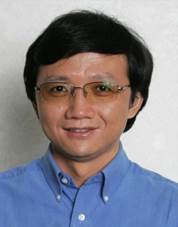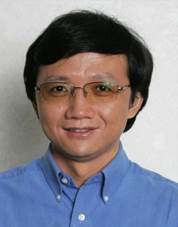石乐明
| 职称 | 教授 |
| 电话 | 021-31246746 |
| 邮箱 | lemingShi@fudan.edu.cn |
| 地址 | 复旦大学生命科学学院D610 |
摘要 | 研究方向: 从事药物基因组学、精准医学、医学大数据、生物信息学及化学信息学等方面的研究和开发工作,旨在提高新药研发的成功率和药物临床应用的有效率。 |
| 工作经历 | 石乐明,复旦大学生命科学学院教授、药物基因组学研究中心主任、复旦-张江临床基因组学联合研究中心主任;国家 863 计划“生物大数据”重大项目总体专家组专家、中国药理学会药物基因组学专业委员会常委、成都市人民政府生物医药产业战略咨询专家。 1985年湖南大学分析化学本科毕业,理学学士;1988 年中国科学技术大学计算化学研究生毕业,理学硕士;1991年中国科学院过程工程研究所计算化学博士研究生毕业,工学博士,后留所任助理研究员(1991年)和副研究员(1993年)。1994年赴美国,先后在凯斯西储大学(研究助理)、美国国立健康研究院肿瘤研究所(访问学者)、美国食品和药品管理局(FDA)、美国家用(惠氏)及巴斯夫等机构和公司任(资深)研究科学家职务。2001年作为原创人之一创办深圳微芯生物科技有限责任公司,任信息学部主任,负责计算机辅助药物分子设计并创建了基于化学基因组学的创新药物研发和筛选平台。2003 年作为资深研究员重新加入美国FDA,发起并领导关于基因芯片和新一代测序质量控制标准和应用的MAQC/SEQC大型国际合作研究计划,其研究成果由Nature出版集团于2006年、2010年和2014年出版3个专辑(www.nature.com/nbt/focus/maqc/, www.nature.com/focus/maqc2/, and www.nature.com/nbt/collections/seqc/),美国FDA依此制订了相应的药物基因组学指南。发表学术论文200多篇(其中11篇发表于Nature Biotechnology),SCI引用8,000多次。获4项创新药物化合物美国专利授权,两个化合物已进入中国III期临床试验,一个进入美国和日本临床试验;参与研发的原创1.1类抗肿瘤新药西达本胺(爱谱沙®)于2014年被中国FDA批准上市,用于治疗复发及难治性外周T细胞淋巴瘤,1.1类原创抗糖尿病新药西格列他钠的3期临床试验即将完成,将于2017年申报上市。 |
| 研究方向 | 从事药物基因组学、精准医学、医学大数据、生物信息学及化学信息学等方面的研究和开发工作,旨在提高新药研发的成功率和药物临床应用的有效率。 |
| 获奖情况 | |
| 代表论文 | 1. Wang J#, Yu Y#, Shen H, Qing T, Zheng Y, Li Q, Mo X, Wang S, Li N, Chai R, Xu B, Liu M, Brindley PJ, McManus DP, Feng Z, Shi L, Hu W. Dynamic transcriptomes identify biogenic amines and insect-like hormonal regulation for mediating reproduction in Schistosoma japonicum. Nature Communications. 8:14693 (2017). 2. Zhu J, Chen G, Zhu S, Li S, Wen Z, Bin Li, Zheng Y*, Shi L*. Identification of Tissue-Specific Protein-Coding and Noncoding Transcripts across 14 Human Tissues Using RNA-seq. Scientific Reports. 6:28400 (2016). 3. Chen G, Schell JP, Benitez JA, Petropoulos S, Yilmaz M, Reinius B, Alekseenko Z, Shi L, Hedlund E, Lanner F, Sandberg R, Deng Q*. Single-cell analyses of X Chromosome inactivation dynamics and pluripotency during differentiation. Genome Research. 26(10), 1342-1354 (2016). 4. MetaSUB International Consortium (Shi L was listed as a co-PI). The Metagenomics and Metadesign of the Subways and Urban Biomes (MetaSUB) International Consortium inaugural meeting report. Microbiome. 4(1), 24 (2016). 5. Zhang W#, Yu Y#, Hertwig F#, …, Shi L*, Peng Z*, Fischer M*. Comparison of RNA-seq and microarray-based models for clinical endpoint prediction. Genome Biology. 16(1), 133 (2015). 6. Peifer M, Hertwig F, Roels F, …, Shi L, …, Thomas RK, Fischer M. Telomerase activation by genomic rearrangements in high-risk neuroblastoma. Nature. 526(7575), 700-704 (2015). 7. Su Z#, Łabaj PP#, Li S#, …, Kreil DP*, Mason CE*, Shi L*. A comprehensive assessment of RNA-seq accuracy, reproducibility and information content by the Sequence Quality Control consortium. Nature Biotechnology. 32(9), 903-914 (2014). 8. Yu Y#, Fuscoe JC#, …, Shi L*, Wang C*. A rat RNA-Seq transcriptomic Bodymap across 11 organs and 4 developmental stages. Nature Communications. 5:3230 (2014). 9. Ostrov DA, Grant BJ, …, Shi L, …, Peters B. Drug hypersensitivity caused by alteration of the MHC-presented self-peptide repertoire. PNAS. 109(25), 9959-9964 (2012). 10. Shi L*, Campbell G, …, Wolfinger RD. The MicroArray Quality Control (MAQC)-II study of common practices for the development and validation of microarray-based predictive models. Nature Biotechnology. 28(8), 827-838 (2010). 11. Shi L*, Reid LH, …, Slikker W, Jr. The MicroArray Quality Control (MAQC) project shows inter- and intraplatform reproducibility of gene expression measurements. Nature Biotechnology. 24(9), 1151-1161 (2006). 12. Guo L, Lobenhofer EK, …, Shi L. Rat toxicogenomic study reveals analytical consistency across microarray platforms. Nature Biotechnology. 24(9), 1162-1169 (2006). 13. Tong W, Lucas AB, …, Shi L. Evaluation of external RNA controls for the assessment of microarray performance. Nature Biotechnology. 24(9), 1132-1139 (2006). |



